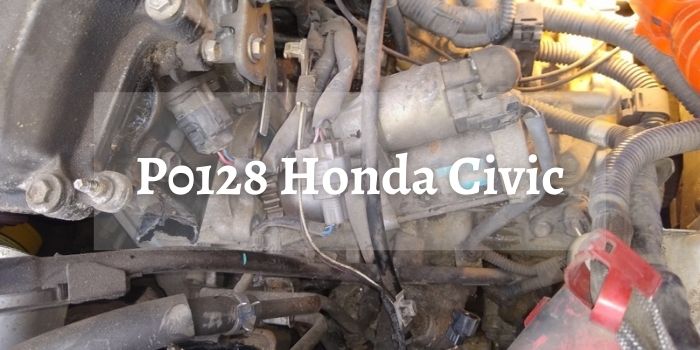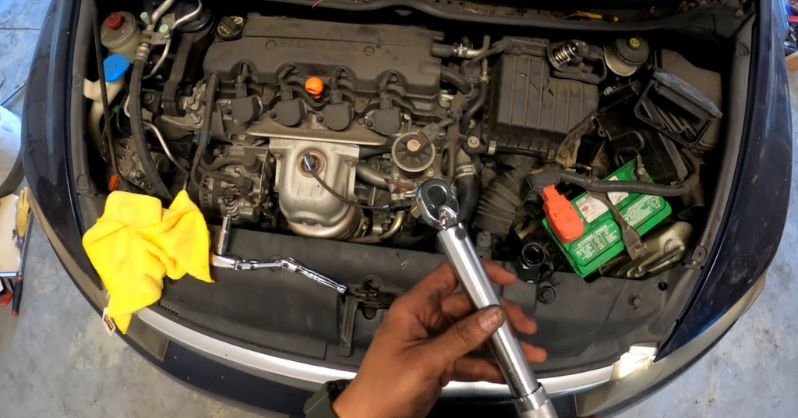For people who are not as well-versed in the terms of automobiles, it can get a bit stressful when faced with an issue. If you’re driving a Honda Civic and are constantly given warning signs but unable to comprehend such codes, then that can pose long-term effects on your car.
One such problem is the p0128 Honda Civic code; this is a frequent problem faced by Honda users. So, keep on reading to find out more about it!

What Does It Mean?
Don’t worry, though! It’s a simple issue and can usually be fixed with a trip to an automobile mechanic. If you see this code sign on your Honda Civic, it simply means that the temperature of your coolant thermostat is below the regulatory temperature for peak effectiveness.
The severity of this error code is usually low; however, it is recommended to get it fixed within a month or two of getting it to prevent any overheating. With that being said, you can still keep on driving your car even after getting the code but for a short while. It’s better to address the issue as soon as possible.
There could be quite a few reasons for triggering this P0128 code; keep on reading to know the reasons. However, it’s important to note that these things can also trigger p0505 honda or P0420 Honda Check Engine Code.
What Are The Symptoms?
Fortunately for you, it’s easy to identify and pinpoint this issue by keeping your eyes out for the symptoms. The p0128 symptoms are:
Heat Deficiency
The primary reason why you’re getting the p0128 code is that it is not getting the heat it requires for the engine to operate at optimum capacity. This suggests that the heater core is not heating the water properly as it passes through, leading to a lack of heat.
In addition, you will also notice that it will take a longer time for your car’s engine to warm up.
Check Engine/Service Engine Light is on
This is the next most probable symptom that you will come across that throws the p0128 code. This is basically the engine’s way of letting you know that it’s time for a check-up.
Reduced Fuel Economy
Issues with the thermostat usually portray a reduced fuel economy. This means that your car will be traveling a lower number of miles using a specific amount of fuel than before, which is likely to increase costs for you.
The temperature reading on the gauge is abnormally low
This symptom is again quite common since the coolant thermostat is regulating a below-par temperature; hence the reading is likely to be unusually low. Therefore, keeping an eye out for this can also indicate the p0128 signal.
What Are The Causes?
It’s crucial to look out for early symptoms to prevent long-lasting damage to the car’s engine. However, if the p0128 code has been already signaled, then these are some of the probable causes:
A malfunctioning or stuck thermostat:
This is usually the most common cause for the trigger code. A stuck open thermostat permits coolant to circulate through the engine at all times. This, as a result, cools the engine excessively and hence preventing the engine from operating at proper temperatures.
It is usually the first place to look at when having issues with the ‘overcooling’ of the engines.
The Coolant temperature circuit has defective wiring:
This is likely to cause electrical problems with the circuit. A faulty circuit and wiring can cause a malfunction which may trigger the code.
A weak or defective coolant temperature sensor
The issue code could also be caused by the intake air temperature sensor, the fan, or the coolant temperature sensor. Hence it is also suggested to check them out along with the thermostat.
A radiator fan that does not switch off
This is again a very self-explanatory cause. If the radiator fan is constantly running, it will allow air to cool down the temperatures even more and hence trigger the p0128 code.
How To Fix Honda P0128 Code

With a Honda p0128 code issue, the first step to fixing it is, to begin with, the simplest repair option pertaining to the low coolant levels.
Step 1: Switch off the Engine
Switch off your engine and wait until it’s cool enough to open your coolant reservoir before proceeding further.
Step 2: Let it Cool
Make sure to open the reservoir once it’s cool, or else a coolant system, when hot, could cause burns and other injuries as they tend to be full of air pressure inside. Check the levels and strength of your coolant and compare it to the prescribed levels in your service handbook and instructions to check for issues.
Only examine your engine and coolant system only when they are cool enough to safely inspect.
Step 3: Check the thermostat
Chances are that a faulty thermostat is the most likely cause of triggering the p0128 code. However, there may be no visual indicators of a faulty thermostat, which can make inspecting and identifying the issue quite challenging.
Step 4: Check other parts
Therefore, it’s recommended to check other parts of the system as well. Such as the radiator fan, coolant temperature circuit as well as coolant sensor before getting a replacement for your thermostat.
If you are still unsure about it and not that well-versed in these, a trip to an automobile may get the job done.
How To Diagnose It
To determine whether there is an issue with the thermostat or the sensor, the best way to do it is to check if the engine is running at its optimal or proper temperatures. However, in a car without a temperature gauge, this can be difficult to ascertain.
Inspecting the heat of an idle car:
Therefore, to diagnose this problem, you can start the engine of your car at cool temperatures and let it sit idle for 10 minutes or more. If the heater produces little to no heat, then there is likely a problem with your thermostat and not the sensor.
Checking Coolant Condition:
Another step could be to check the coolant system itself and see what its condition is. Rusting and poor coolant conditions can lead to blocking, and the thermostat is stuck. In such cases, it’s better to replace the old coolant before flushing the system, or you can also check for leakages.
Inspecting for sensor problems:
After diagnosing these, you still are unable to determine the issue and suspect a sensor problem. Then you can check the temperature by using a multimeter. The ohm reading will alter as the temperature changes.
Therefore, if the reading doesn’t change with the temperature, then replace the temperature sensor or check if the wiring is damaged or not.
Inspecting the Thermostat:
A stuck open thermostat is one of the most common triggers of the p0128 code. Feeling the radiator hose and monitoring how hot the coolant temperature is when it starts flowing through the radiator hose is an easy approach to identify this. However, caution should be taken when doing this due to the risk of getting burned.
The radiator hose is likely to heat up rapidly when the thermostat opens. Hence if it doesn’t, and heats up quite slowly, then the thermostat is likely jammed open and may need to be changed.
Is It Serious?
This p0128 code doesn’t require immediate attention. However, it is recommended to get the issue addressed soon to avoid any long-lasting damage to your engine.
Therefore, it is safe to assume that the severity of the issue and repair urgency are both low, however not to be looked over.
What’s The Cost to Fix It?
The cost of fixing a Honda Civic p0128 code highly depends on 2 factors. If you take your car to a mechanic, then the cost will depend on:
Hourly Rate:
The time it takes to diagnose the issue of your p0128 will vary depending on the labor rate of the stores. This might range from around $60 to $140.
Repairs and Replacements:
This depends on which equipment needs fixing and replacing. For example, a coolant temperature sensor replacement ranges from $150 to $195 on average.
On the other hand, a thermostat replacement costs between $215 to $255 on average. Other parts may need changes or repairs, but that may depend significantly depending on the related issues.
Conclusion
A p0128 Honda Civic will not pose a major risk to your car’s immediate driving capabilities. It is wise to keep in mind that most fuel engines these days operate in temperatures of 200 degrees or higher. Therefore, extended exposure to a cooler environment may cause complications in the long run.
Therefore, when in doubt, get your car looked at by professionals to avoid any significant complications.
Related Posts:
P0411 Volkswagen: What Does It Mean & How You Can Fix It
P0015 Mercedes: What Does It Mean?
P0300 Volkswagen: What Does It Mean And How to Fix It?
P0134 Honda Error Code: The Ultimate Guide
What Is The Powertrain | Learn About the Heart of Your Vehicle